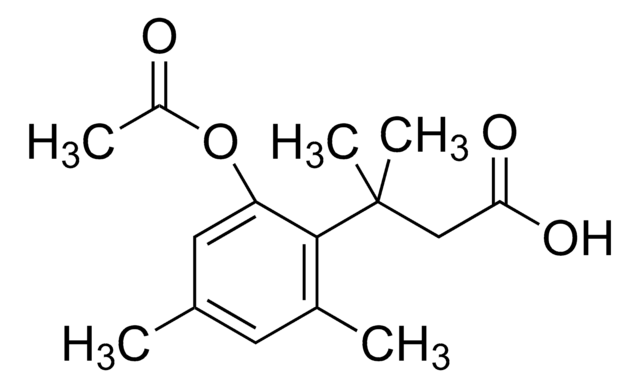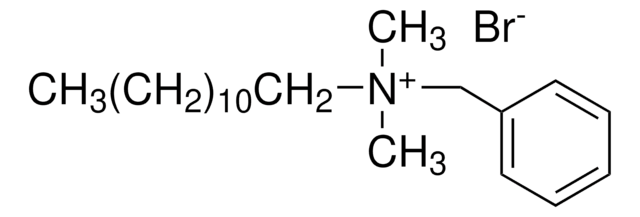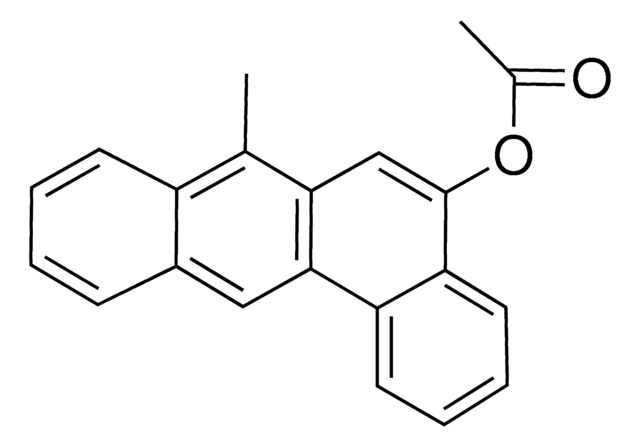776181
3-(2-Acetoxy-4,6-dimethylphenyl)-3-methylbutyric acid N-succinimidyl ester
95%
別名:
3-(2-Acetoxy-4,6-dimethylphenyl)-3-methylbutyric acid N-hydroxysuccinimide ester, Trimethyl lock NHS, Trimethyl lock succinimidyl ester
ログイン組織・契約価格を表示する
すべての画像(1)
About This Item
実験式(ヒル表記法):
C19H23NO6
分子量:
361.39
MDL番号:
UNSPSCコード:
12352106
PubChem Substance ID:
NACRES:
NA.22
おすすめの製品
品質水準
アッセイ
95%
形状
solid
mp
107-112 °C
保管温度
2-8°C
SMILES記法
CC(=O)Oc1cc(C)cc(C)c1C(C)(C)CC(=O)ON2C(=O)CCC2=O
InChI
1S/C19H23NO6/c1-11-8-12(2)18(14(9-11)25-13(3)21)19(4,5)10-17(24)26-20-15(22)6-7-16(20)23/h8-9H,6-7,10H2,1-5H3
InChI Key
KMNOKEFBKJGRFL-UHFFFAOYSA-N
関連するカテゴリー
アプリケーション
This ′trimethyl lock′ derivative is activated with a succinimidyl ester for modification of amine containing compounds and biomolecules. After modification of your amine of interest, your now ′masked′ molecule can be released by cleavage of the ester, which can be achieved by cellular esterases. This triggers a rapid lactonization reaction of the ′trimethyl lock′ to regenerate your original amine-containing molecule. This approach has been applied to release of fluorophores, peptides, nucleic acids as well as small molecule drugs.
適用法令
試験研究用途を考慮した関連法令を主に挙げております。化学物質以外については、一部の情報のみ提供しています。 製品を安全かつ合法的に使用することは、使用者の義務です。最新情報により修正される場合があります。WEBの反映には時間を要することがあるため、適宜SDSをご参照ください。
Jan Code
776181-250MG:
776181-BULK:
776181-50MG:
776181-VAR:
最新バージョンのいずれかを選択してください:
Michael N Levine et al.
Chemical science, 3(8), 2412-2420 (2012-11-28)
The trimethyl lock is an o-hydroxydihydrocinnamic acid derivative in which unfavorable steric interactions between three pendant methyl groups encourage lactonization to form a hydrocoumarin. This reaction is extremely rapid, even when the electrophile is an amide and the leaving group
Michael N Levine et al.
Molecules (Basel, Switzerland), 13(2), 204-211 (2008-02-29)
p-Nitrophenyl acetate is the most commonly used substrate for detecting the catalytic activity of esterases, including those that activate prodrugs in human cells. This substrate is unstable in aqueous solution, limiting its utility. Here, a stable chromogenic substrate for esterases
ライフサイエンス、有機合成、材料科学、クロマトグラフィー、分析など、あらゆる分野の研究に経験のあるメンバーがおります。.
製品に関するお問い合わせはこちら(テクニカルサービス)








